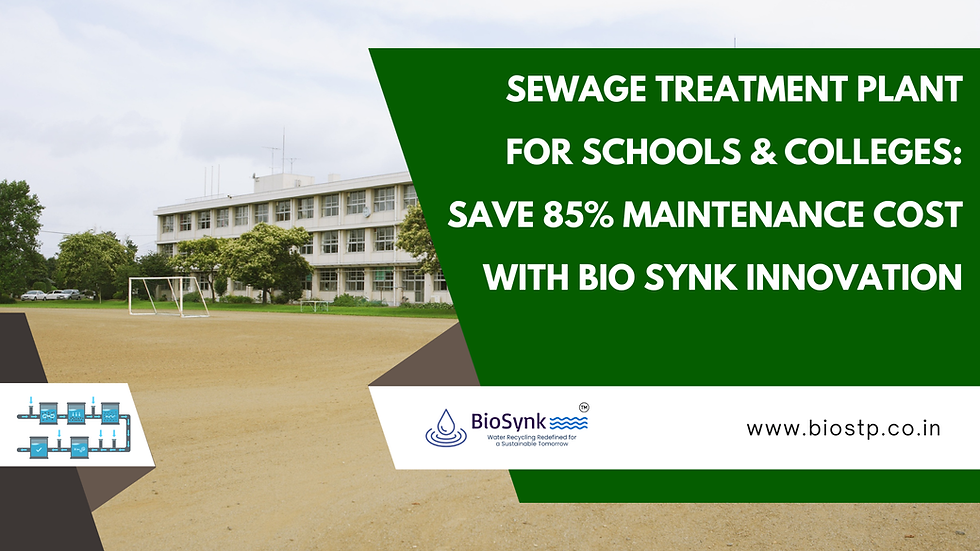Flush to Fresh: How Sewage Water Gets Treated Underground
- MARKETING BIOSYNK
- Aug 22
- 3 min read

Introduction
Water is the essence of life, yet every day millions of liters of sewage water are generated from homes, industries, apartments, and commercial spaces. If left untreated, this wastewater pollutes rivers, lakes, and groundwater. The answer lies in an efficient sewage treatment plant (STP) that works silently beneath the ground-transforming sewage into safe, reusable water. In this article, we explore how sewage water is treated underground, why bio STPs are the most eco-friendly solution, and how Bio Synk is leading the way with advanced wastewater management systems.
1. What Is Sewage Treatment and Why It Matters
Sewage treatment is the scientific process of removing contaminants, harmful microorganisms, and solid waste from wastewater before it is discharged into the environment. Without treatment, sewage leads to foul odors, mosquito breeding, and dangerous waterborne diseases. A well-designed bio STP ensures that untreated sewage does not reach natural water sources. Instead, it purifies the wastewater and allows it to be safely reused for gardening, flushing, or even industrial cooling.
2. The Underground Journey of Sewage Water
When you flush your toilet, the wastewater begins a silent journey underground. It first passes through pipelines and enters the sewage treatment plant. Inside the STP, multiple stages take place-screening, sedimentation, biological treatment, and filtration. By the end of this underground journey, the water comes out clean, odor-free, and safe to be recycled. This hidden process is the backbone of sustainable urban living.
3. Stages of Sewage Treatment: From Dirty to Clean
The sewage treatment process typically happens in three major stages:
Primary Treatment – Removal of larger particles like plastics, rags, and grit.
Secondary Treatment – Biological treatment using bacteria and microbes that break down organic waste.
Tertiary Treatment – Advanced filtration, UV disinfection, or chlorination to make water reusable.
Each stage is carefully designed so that untreated sewage is converted into clean, reusable water without harming the environment.
4. The Growing Problem of Untreated Wastewater
India generates over 72,000 million liters of sewage daily, but less than half of it gets treated. The rest ends up in rivers and groundwater, polluting drinking sources and causing health hazards. Urban areas like apartments, hotels, malls, and industries face increasing pressure to install sewage treatment plants to comply with CPCB and PCB regulations. Ignoring sewage management not only leads to penalties but also creates a massive environmental burden.
5. Why Bio STPs Are the Future of Wastewater Management
Traditional STPs require high energy, frequent maintenance, and release harmful sludge. In contrast, Bio STPs use advanced biological technology like MBBR, SBR, and MBR to treat sewage naturally. They are compact, odor-free, energy-efficient, and eco-friendly. By choosing a bio STP, businesses, apartments, and industries save money on operations while contributing to a greener planet.
6. Benefits of an Underground Bio Sewage Treatment Plant
Space Saving: Can be installed below ground without disturbing surroundings.
Odor Control: Advanced technology ensures zero foul smell.
Low Maintenance: Requires minimal operator supervision.
Cost-Effective: Saves water bills by recycling treated water.
Eco-Friendly: Reduces pollution and conserves natural water bodies.
This makes underground bio STPs the best choice for modern cities where space is limited and sustainability is a priority.
7. Who Needs a Sewage Treatment Plant?
STPs are no longer optional-they are mandatory for apartments with more than 20 flats, commercial spaces like hotels and malls, IT parks, hospitals, educational institutions, and industries. Even independent houses in water-scarce regions are turning to bio septic tanks and small-scale STPs to manage wastewater effectively. In short, any establishment that generates sewage has a responsibility to treat it before releasing it into the environment.
8. Why Choose Bio Synk for Sewage Treatment Solutions
At Bio Synk, we specialize in designing, installing, and maintaining eco-friendly bio sewage treatment plants. Our systems are CPCB-compliant, highly durable, and customized to suit residential, commercial, and industrial needs. With our advanced technology, you get a silent underground solution that converts sewage into reusable water without odors, noise, or high maintenance. When you choose Bio Synk, you choose reliability, compliance, and sustainability.
9. Let’s Build a Cleaner, Greener India Together
Every drop of treated sewage water saves a drop of fresh water for future generations. By installing a bio STP today, you not only comply with government norms but also contribute to the vision of a sustainable and water-secure India. Let’s move from flush to fresh-transforming waste into a resource and pollution into purity. Together, we can build cities that are clean, green, and future-ready.




Comments